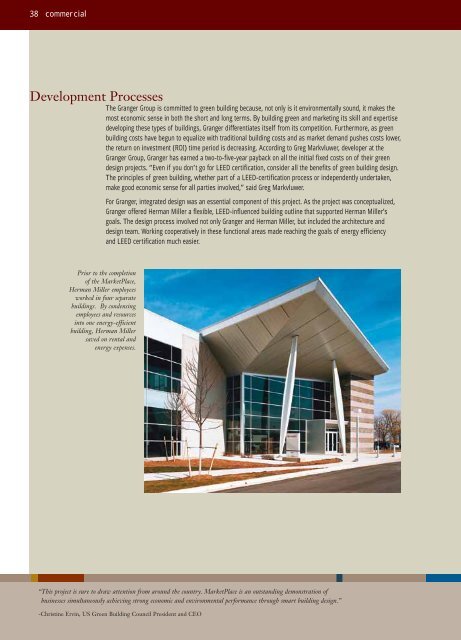Building Green for the Future - US Environmental Protection Agency
Building Green for the Future - US Environmental Protection Agency
Building Green for the Future - US Environmental Protection Agency
You also want an ePaper? Increase the reach of your titles
YUMPU automatically turns print PDFs into web optimized ePapers that Google loves.
38 commercial<br />
Development Processes<br />
The Granger Group is committed to green building because, not only is it environmentally sound, it makes <strong>the</strong><br />
most economic sense in both <strong>the</strong> short and long terms. By building green and marketing its skill and expertise<br />
developing <strong>the</strong>se types of buildings, Granger differentiates itself from its competition. Fur<strong>the</strong>rmore, as green<br />
building costs have begun to equalize with traditional building costs and as market demand pushes costs lower,<br />
<strong>the</strong> return on investment (ROI) time period is decreasing. According to Greg Markvluwer, developer at <strong>the</strong><br />
Granger Group, Granger has earned a two-to-five-year payback on all <strong>the</strong> initial fixed costs on of <strong>the</strong>ir green<br />
design projects. “Even if you don’t go <strong>for</strong> LEED certification, consider all <strong>the</strong> benefits of green building design.<br />
The principles of green building, whe<strong>the</strong>r part of a LEED-certification process or independently undertaken,<br />
make good economic sense <strong>for</strong> all parties involved,” said Greg Markvluwer.<br />
Prior to <strong>the</strong> completion<br />
of <strong>the</strong> MarketPlace,<br />
Herman Miller employees<br />
worked in four separate<br />
buildings. By condensing<br />
employees and resources<br />
into one energy-efficient<br />
building, Herman Miller<br />
saved on rental and<br />
energy expenses.<br />
For Granger, integrated design was an essential component of this project. As <strong>the</strong> project was conceptualized,<br />
Granger offered Herman Miller a flexible, LEED-influenced building outline that supported Herman Miller’s<br />
goals. The design process involved not only Granger and Herman Miller, but included <strong>the</strong> architecture and<br />
design team. Working cooperatively in <strong>the</strong>se functional areas made reaching <strong>the</strong> goals of energy efficiency<br />
and LEED certification much easier.<br />
“This project is sure to draw attention from around <strong>the</strong> country. MarketPlace is an outstanding demonstration of<br />
businesses simultaneously achieving strong economic and environmental per<strong>for</strong>mance through smart building design.”<br />
-Christine Ervin, <strong>US</strong> <strong>Green</strong> <strong>Building</strong> Council President and CEO

















